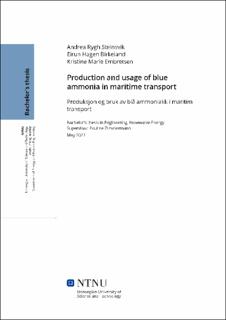| dc.contributor.advisor | Zimmermann, Pauline | |
| dc.contributor.author | Steinsvik, Andrea Rygh | |
| dc.contributor.author | Birkeland, Eirun Hagen | |
| dc.contributor.author | Embretsen, Kristine Marie | |
| dc.date.accessioned | 2023-06-30T17:21:31Z | |
| dc.date.available | 2023-06-30T17:21:31Z | |
| dc.date.issued | 2023 | |
| dc.identifier | no.ntnu:inspera:142213037:147032154 | |
| dc.identifier.uri | https://hdl.handle.net/11250/3074907 | |
| dc.description.abstract | Maritim transportsektor sliter med å oppnå nullutslipp innen 2050. Betydelig reduksjon av utslipp kan oppnås ved å bytte fra Tungolje (HFO) til lavkarbon drivstoff som ammoniakk, hydrogen og biodrivstoff.
Ammoniakk har fanget interessen som et alternativt drivstoff i den maritime sektoren på grunn av dens egenskaper, som nullutslipp av karbon, og hvordan den lett kan lagres og fylles på tanker, noe som gjør den kompatibel med langdistanse shipping.
Målet med denne bachloren er å diskutere forskjellige teknologier og løsninger for produksjon av blå ammoniakk. Målet er også å vurdere hvordan ammoniakk fungerer som et maritimt drivstoff med hensyn til teknologiske, utslipps- og økonomiske aspekter. Utfordringer med sikkerhet og lagring blir også vurdert.
En case-studie ble gjennomført for å se på ammoniakk, HFO og biodiesel når det gjelder utslipp gjennom hele livssyklusen, effektivitet og kostnader for bruk. HFO er tradisjonelt det mest brukte drivstoffet i maritim transport og ble brukt som referanse, og biodiesel er et nytt og fremtredene drivstoff som har et stort potensial for utslippsreduksjon. Case-studien omfattet oljetankeren Fure Valö som reiser fra Mongstad til Reykjavik. Dette er en mellomlang rute med en avstand på 1000 NM. Ruten er allerede i bruk av Fure Valö og er en god avstand for å sammenligne de forskjellige drivstoffene og skaffe objektive resultater som ble representert i bacheloroppgaven.
Beregninger med hjelp av MATLAB og verktøy som SimaPro ble brukt for å presentere en LCA. Målet med denne LCAen var å sammenligne resultatene fra livssyklusen fra hvert drivstoff. Dette ble brukt for å få kunnskap om hvilket drivstoff som var det beste alternativet for å bidra til prosessen med avkarboniseringen i den maritime sektoren.
Resultatet fra casen viser at for å reise fra Mongstad til Reykjavik, trengte man langt mer ammoniakk enn HFO og biodiesel. Av disse drivstoffene hadde ammoniakk generelt en minimal mengde utslipp siden ammoniakk ikke slipper ut CO2. Imidlertid var utslippene av NOx ganske høye sammenlignet med HFO og biodiesel. Som et resultat av NOx -avgift, CO2-priser og mengde ammoniakk nødvendig, blir prisen på ammoniakk svært høy sammenlignet med den tradisjonelle og relative billige HFO, og til lavkarbon alternativet biofuel. | |
| dc.description.abstract | The Maritime transportation sector is facing challenges in achieving zero emissions by 2050. Significant reduction in emissions can be accomplished by transitioning from Heavy fuel oil (HFO) to low-carbon fuels such as ammonia, hydrogen and biofuels.
Ammonia has caught the interest as an alternative fuel in the maritime sector due to its characteristics such as zero-carbon emissions. It is also easily stored and filled in tanks, making it compatible with long-distance shipping.
This thesis aims to discuss the different technologies and solutions for blue ammonia production. The objective of this thesis is also to evaluate the performance of ammonia as a maritime fuel from technological, emission and economic perspectives. Main challenges with safety and storage are also considered.
A case study was performed to look at ammonia, HFO and biodiesel on aspects such as emissions throughout their life cycle, effectiveness and costs for utilization. HFO is traditionally the most used fuel in maritime transport and was used as a reference, and biodiesel is a new and upcoming fuel that have a high capacity for emission reduction. The case study involved the chemical/oil tanker Fure Valö which traveled from Mongstad to Reykjavik. This was a middle-length route with the distance of 1,000 NM. The route is already in use by Fure Valö and is a good distance to compare the different fuels to get objective results that were represented in the thesis.
Calculations with the help of MATLAB and tools such as SimaPro were used to present an LCA. The goal of this LCA was to compare the impacts from the life cycle from each fuel. This was used to gain knowledge on which fuel came out as the better alternative to contribute to the process of decarbonization in the maritime sector.
The case study found that to travel the distance from Mongstad to Reykjavik, the volume of ammonia needed was far more than HFO and biodiesel. Between these fuels, ammonia had an overall minimal amount of CO2 emissions. However, in regards to NOx , the emissions were quite high compared to HFO and biodiesel. As a result of NOx tax, CO2 price and the amount of ammonia required, the cost of ammonia was exceptionally high compared to the traditional and relatively cheap HFO, and to the alternative low-carbon fuel, biodiesel. | |
| dc.language | eng | |
| dc.publisher | NTNU | |
| dc.title | Production and usage of blue ammonia in maritime transport | |
| dc.type | Bachelor thesis | |
